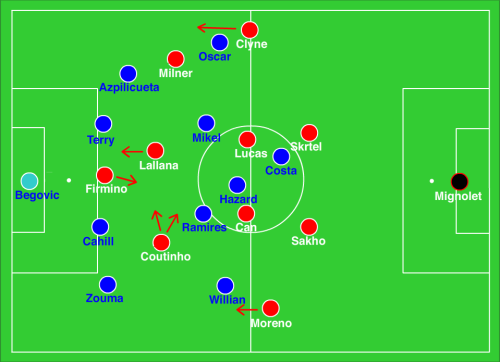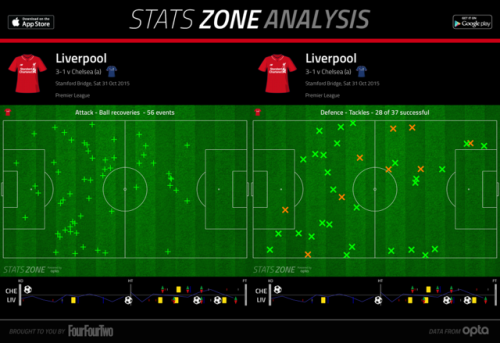Chelsea and Jose Mourinho were knocked out of the League Cup in their last match, losing to Stoke City on penalty kicks, but their performance was a slight improvement upon their other recent matches.
Liverpool won their League Cup match thanks to a goal by Nathaniel Clyne and Jurgen Klopp’s tactics are beginning to take hold at the Merseyside club.
Mourinho set his side out in his typical 4-2-3-1, but regulars in Fabregas, Matic, and Ivanovic were on the bench in favour of Mikel, Ramires, and Zouma. Eden Hazard played just behind Diego Costa while Oscar played from the left.
Under Klopp, Liverpool have looked very much like a 4-3-2-1 with Milner, Lucas, and Can anchoring the midfield and allowing Coutinho and Lallana to support the striker. However, against Chelsea, Liverpool looked much more like a 4-2-3-1 with Milner in a more advanced position. Lallana played centrally behind Firmino and Coutinho started on the left.

Liverpool’s Shape and Press
Liverpool’s pressing has improved significantly under Klopp since the German took over just a few weeks ago. As mentioned above, the shape was slightly altered with Liverpool looking more like a 4-2-3-1 than a 4-3-2-1 with Milner (who was very poor on the day) playing on the right of the attacking three. Although Milner’s side seemed to be where Liverpool forced Chelsea to play when the home side were building out of the back. This could be for a number of reasons, the first being that Milner’s defensive qualities are better than Coutinho’s and second being that Azpilicueta is naturally right footed, but plays as a left back. Another reason was Oscar’s habit to come inside when Chelsea had the ball, meaning when Azpilicueta did get on the ball, he was unable to find a player without significant pressure on them.
With that said, Liverpool pressed well across the middle third of the pitch. If they weren’t able to win the first the ball in the first phase of their press, they certainly won the second ball and were able to get right back at Chelsea. Mikel and Ramires lacked the ability on the ball to get out of situations when they were being pressed by Coutinho, Lallana, Firmino, Can, or Lucas so Liverpool were able to win the ball back numerous times when Chelsea’s defensive midfielders got on the ball.

As mentioned before, Oscar was narrow at times (in the second half he and Hazard switched) and this hurt Chelsea going forward. Hazard and Costa showed some lateral movement, but Chelsea struggled to play into those forward two because Liverpool were able to maintain a compact shape and as seen above, Liverpool were able to win the ball back in the middle third majority of the time. The bright spot for Chelsea was Willian. The Brazilian was a constant outlet for Chelsea and he was able to get by Liverpool’s pressing with his pace and directness, but rarely was he offered support by his teammates and often found himself isolated with Liverpool players around him.

Space Between the Lines
In the opening minutes of the match, Chelsea were all over Liverpool and got a goal because of it. For the few minutes after that goal, Lucas, in particular, was caught out in the space between the lines for Liverpool. Costa, Hazard, Willian, and Oscar all seemed to be finding space around the defensive midfielder and he struggled to cope with the direct runs from the likes of Willian. However, Liverpool’s pressing began to dictate the match and the Merseyside club were able to maintain possession, with both of these aspects taking the pressure off of Lucas. The Brazilian went from having a very poor game to having a good one. He made a number of forward runs both with and without the ball (a memorable one being when he won a header over Kurt Zouma). Following that early period where Chelsea were able to give Lucas trouble, they were really unable to worry Liverpool in those spaces.
Liverpool, however, took full advantage of the gaps between Chelsea’s midfield and back four. The movement of Coutinho, Lallana, and Firmino made it difficult for Chelsea to track the runs and thus the space between the lines began to open up for the away side. At times the trio would all occupy that space, making it difficult for Mikel and Ramires and leaving Terry and Cahill without a man to mark. Other times the fluidity between Firmino and Lallana (the former would drop off and the latter would make forward runs) made it difficult for the Chelsea players to pick up the Liverpool players moving between the lines. Below is a good example of the the space between Chelsea’s back four and midfield. At this point, with Benteke on, it was even more noticeable as the Belgian centre forward was ever present in pushing back Cahill and Terry.

Coutinho played a lot in the left half space and Firmino and Coutinho would overload the left channel area, while Lallana would drift around centrally and to the left as well. Overall, the movement of the trio was excellent and it was supported by the passing of Mamadou Sakho from the back. The French centre back broke the midfield lines numerous times with his passing, finding Coutinho, Lallana, and Firmino in that pocket of space, typically with time to turn. You can see below that Coutinho and Firmino worked around that similar area of the pitch and Sakho was able to find them ten times throughout the match, while he found Lallana four times with similar passes.

A lot of this space was initially created by the width that Moreno and Clyne offered on either side. Much of Liverpool’s play, particularly in the first half was out wide. In the first half, it seemed like everytime Liverpool got the ball, they looked to Moreno on the left or Clyne and Milner on the right and then looked to play a cross into the box. Interestingly, majority of the crosses that Liverpool played were before Benteke came on the pitch. With that, Chelsea’s midfield was stretched. Willian had to cover the forward runs of Moreno and Oscar had to do the same with Clyne so that meant when Chelsea were defending, and their shape looked like a 4-4-1-1 with Hazard just behind Costa, that their midfield was stretched, which allowed the passing lanes from the likes of Sakho to Coutinho and Firmino to open up.
Below you can see the build up to Coutinho’s second goal. Sakho has played a big diagonal out to Benteke, but the interesting bit here is that, again, Coutinho is between the lines and unmarked which allowed him to get on the end of Benteke’s knock down easily.

Changes
The first significant change of the match was Mourinho’s reaction to scoring in the opening minutes of the match. Chelsea were all over Liverpool prior to the goal, both defensive and going forward, but once they scored, Chelsea sat deep, allowed Liverpool to have the ball and were unable to get out of their low block with any consistency. Overall, Chelsea had two shots on goal; the Ramires goal and Oscar’s strike from the halfway line. With their defensive record as is, it was a bit of surprise that Mourinho had his side defend so deep. Chelsea have just two clean sheets this season and are tied for the fourth highest amount of conceded goals.
For Liverpool, Benteke’s introduction was significant for a number of reasons. Obviously, he was gave Liverpool an aerial option up top and this was important in the build up to Coutinho’s second goal and his own goal, but interesting enough Liverpool attempted less crosses following Benteke’s substitution on. As mentioned above, however, he was a constant up top in that he pushed back Cahill and Terry and allowed the space between the lines to became even more gapping for Liverpool’s playmakers to operate in and dictate the game.
Mourinho tried to get an attacking influence on the match, replacing Mikel with Fabregas and Azpilicueta with Falcao, but at that point, momentum had shifted significantly.
Conclusion
Chelsea could have gone on to win this match. They got an early goal and could have continued bringing the game to Liverpool, but instead, they sat back and allowed Liverpool to control the game.
Liverpool were bright both with and without the ball and Klopp’s influence is starting to be seen. It was certainly the best game for Klopp so far, based on the result and performance, but the German will have pointed out a number of areas that still need improvement.
Where does Mourinho go from here?
Peter Motzenbecker
Latest posts by Peter Motzenbecker (see all)
- Liverpool vs Manchester City: Tactical Analysis - January 17, 2018
- The Manchester Derby: Post-Match Tactical Analysis - September 13, 2016
- Arsenal vs Liverpool: The Tactical View - August 17, 2016
